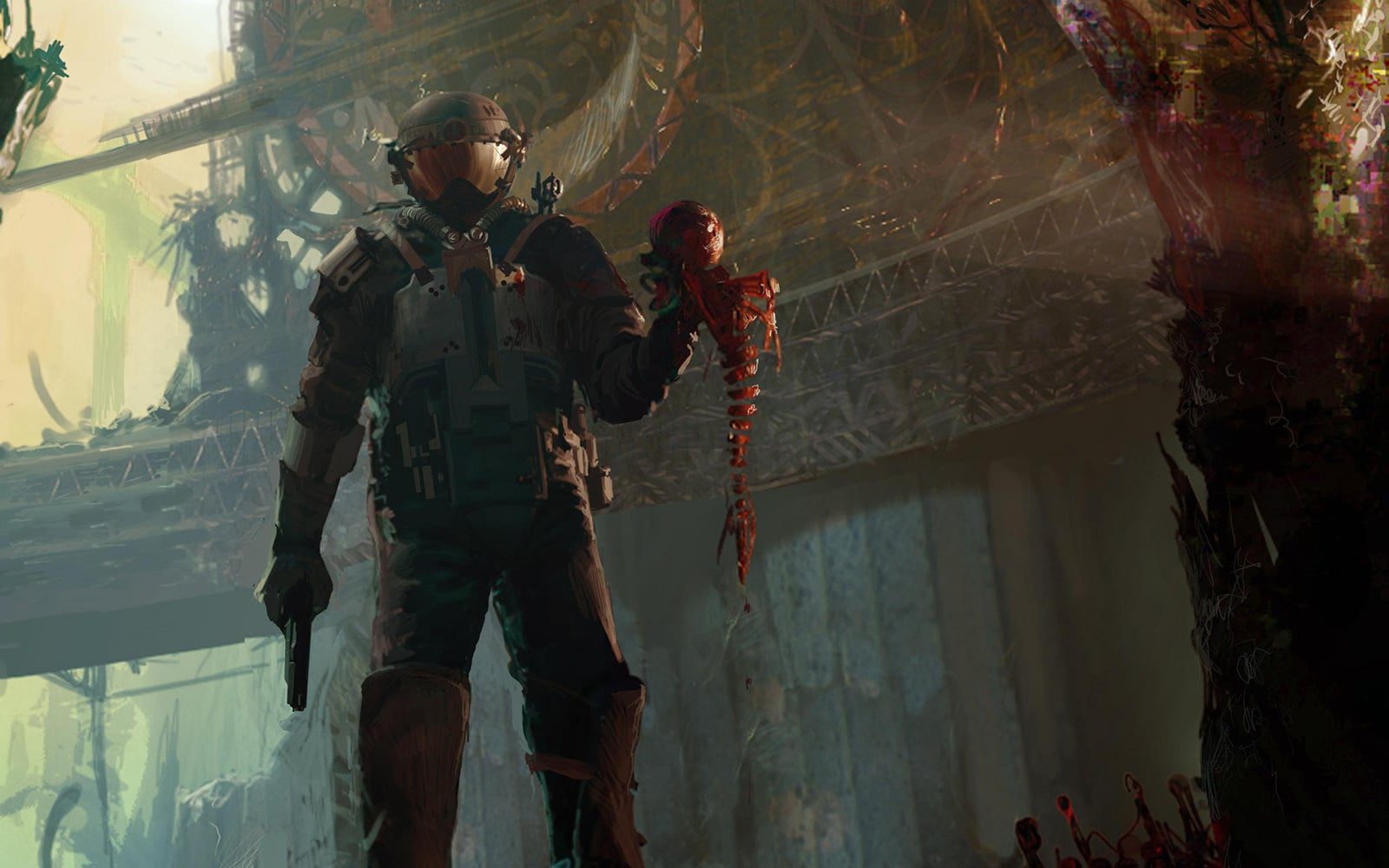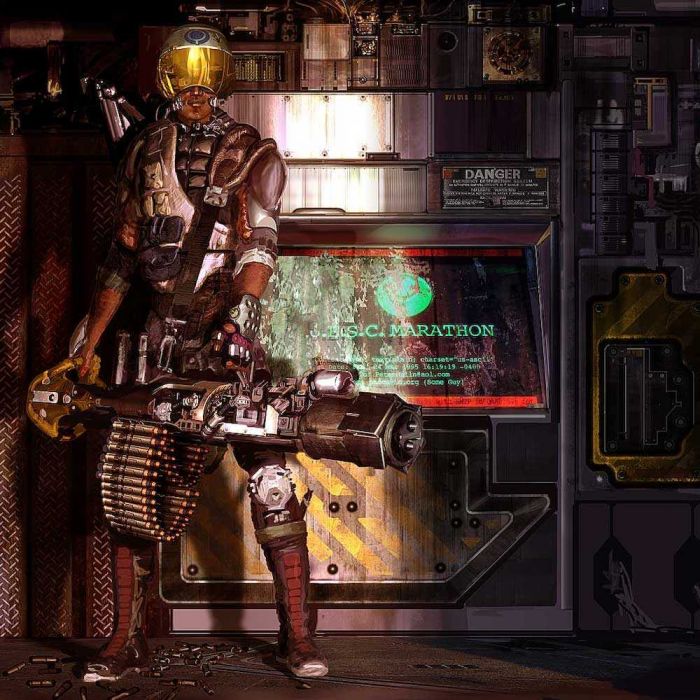Before There Was Halo, There Was Marathon

November 2021 marks the 20th anniversary of Halo: Combat Evolved. The Halo franchise contains some of my favorite video games, so I’ll be posting a few articles on Opus to mark the occasion — and to prep myself for December’s release of Halo Infinite.
Before they released Halo: Combat Evolved in 2001, Bungie had established themselves as one of the Mac community’s top video game developers. (Which, for some Mac users, made their jump to the hated Microsoft feel like something akin to betrayal.) And though Bungie had released several popular and successful games during this period of time, they were most famous for the Marathon trilogy of first-person shooters.
Released between 1994 and 1996, the three Marathon games — Marathon, Marathon 2: Durandal, and Marathon Infinity — were critical and commercial hits thanks to their elaborate storyline, groundbreaking (at the time) visuals and gameplay, and customizability. I don’t think it’s too much of a stretch to say that they served as a foundation for Bungie’s later work on Halo. Without detracting from either franchise, it’s tempting to wonder if Halo would even exist, and if so, in what form, if not for the Marathon games.
For starters, there’s some considerable overlap between Halo and Marathon. Most obviously, both franchises have, as their protagonist, a cybernetically enhanced super-soldier who must battle through impossible odds while accompanied and directed by AI companions. Oh, and at least one of those companions is going rampant, i.e., becoming increasingly unstable and hostile. The Halo games also include numerous references to the Marathon franchise, such as:
- The Master Chief’s MJOLNIR armor shares its name with a group of cyborgs in Marathon.
- Cortana’s name comes from the same mythos that inspired the name of Durandal, one of Marathon’s AIs. And both AIs are named after mythical swords.
- Some of Halo’s aliens, like the Hunters, bear a very close resemblance to aliens in Marathon.
- Halo levels and multiplayer maps are inspired by Marathon levels.
- Halo 2’s soundtrack contains references to Marathon 2’s theme song.
The Halo games also include numerous appearances of the Marathon logo. Some of these are pretty obscure and even silly (e.g., the Marathon logo appears on the tip of one character’s pipe). But the logo’s most noteworthy appearance is as the glyph for “Reclaimer,” which is the Forerunner term for humanity.
Admittedly, a lot of these references are trivial, and more than likely intended as inside jokes by Bungie’s developers. (Not surprisingly, the post-Bungie Halo games contain far fewer Marathon references.) Instead, I’d argue that Halo’s biggest “debt” to Marathon lies in the approach and scope of its narrative.
Like Marathon before it, Halo elevates the first-person shooter by combining it with an epic sci-fi storyline filled with twists and reveals that consistently challenge and undermine the player’s understanding of what’s actually going on. Halo begins with a simple “save humanity from the nasty aliens” storyline. Everything’s going fine and then suddenly, without warning, you’re confronted with saving the entire galaxy from an ancient, unknown threat. But Marathon did it first. And made it weirder. Waaaay weirder.

In Marathon, you play the aforementioned super-soldier (usually called the Cyborg or the Marine) who’s stationed aboard the titular spaceship en route to a distant human colony in the year 2794 A.D. When the Marathon is attacked by alien slavers called the Pfhor, it’s up to you to defend the ship and her crew. In the process, you begin to unravel mysteries surrounding the Marathon’s three AIs (and in particular, the rampant Durandal) even as you’re caught in the crossfire between the Pfhor and another alien race called the S’pht, who have rebelled against their Pfhor captors.
Marathon 2 takes place nearly two decades after the first game. Durandal has taken you to Lh’owon, the S’pht homeworld, in order to find information that will stop the Pfhor, who are apparently planning to attack Earth. This involves seeking out a lost S’pht clan while also protecting Durandal from the machinations of Tycho, one of Marathon’s other AIs who has joined forces with the Pfhor. And if that weren’t enough, you encounter an AI named Thoth who was created by the Jjaro, an ancient and extremely advanced alien race that disappeared from the galaxy millions of years ago.
But all of that is pretty straightforward compared to the final Marathon game. Marathon Infinity begins with the Pfhor destroying Lh’owon with a powerful Jjaro weapon that caused its star to go nova. But in doing so, the Pfhor unwittingly free the W’rkncacnter, a chaotic entity whose very existence threatens the galaxy. The Cyborg suddenly begins traveling across alternate timelines and realities, searching for a way to stop the W’rkncacnter. Eventually, he’s able to activate an ancient Jjaro facility that prevents the W’rkncacnter from ever escaping in the first place, thus saving the galaxy.
The Cyborg’s ultimate fate is left unresolved, however. Instead of a more traditional ending, Marathon Infinity jumps billions of years into the future, and leaves you with a cryptic epilogue set during the final “quantum moment” of the universe’s existence. I can still remember finally beating Marathon Infinity, and scratching my head at the final screen. It was weird and confusing to be sure, but I also had the distinct sense that I’d just played something truly unique.
So far, Halo’s storyline hasn’t come close to being that trippy or cryptic (though it does get plenty convoluted with all of the Forerunner stuff). But Marathon’s approach to storytelling, both in terms of scope and delivery (the Marathon games contain very little dialog, so most of the story is delivered via terminals — something Halo has done, too), clearly laid the foundation for how Bungie would deliver Halo’s narrative. Given Halo’s success and status over the last two decades, and the hype surrounding the upcoming Halo Infinite, I’d say such an approach has proven quite successful.
Although the Marathon series has clearly been overshadowed by its spiritual successor, it’s still around thanks to Bungie’s commitment and an active fan community. Fans have released several unofficial sequels and scenarios that include survival horror and even the Italian Renaissance. As for the original Marathon games, all three are available as free downloads for Mac OS, Windows, and Linux, and have also been released for iPad and iPhone.
If you’re a Halo fan, or just a fan of first-person shooters in general, and you’d like to see where Halo got some of its most basic and fundamental ideas, then I’d suggest trying them out.